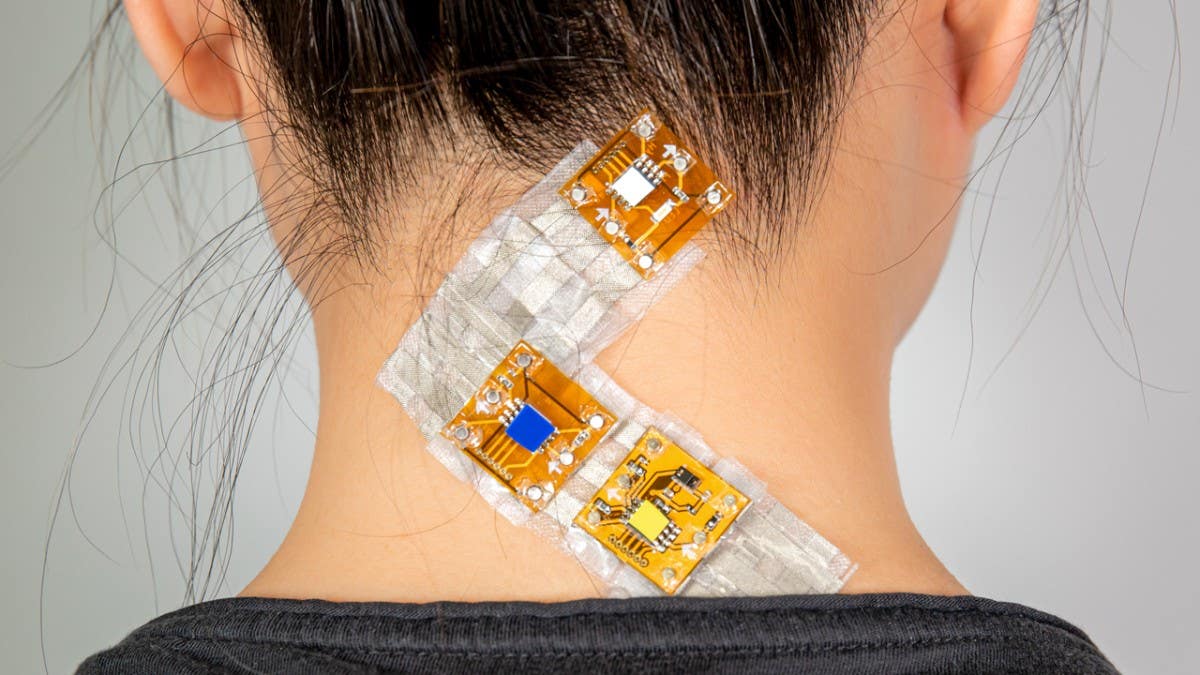New ‘smart tattoos’ revolutionize on-skin computing
The emergence of on-skin interfaces has created an opportunity for seamless, always-available on-body interactions.

[Nov 13, 2022: Becka Bowyer, Cornell University]
The SkinKit wearable sensing interface, developed in the Hybrid Body Lab, can be used for health and wellness, personal safety, as assistive technology and for athletic training, among many applications. (CREDIT: Dmitry-Kireev_Nat-Nano-Anigif)
The emergence of on-skin interfaces has created an opportunity for seamless, always-available on-body interactions. However, developing a new fabrication process for on-skin interfaces can be time-consuming, challenging to incorporate new features, and not available for quick form-factor preview through prototyping.
Researchers at Cornell University have come up with a reliable, skin-tight computing system that’s easy to attach and detach, and can be used for a variety of purposes – from health monitoring to fashion.
On-skin interfaces – sometimes known as “smart tattoos” – have the potential to outperform the sensing capabilities of current wearable technologies but combining comfort and durability has proven challenging.
“We’ve been working on this for years,” said Cindy (Hsin-Liu) Kao, assistant professor of human centered design, and the study’s senior author, “and I think we’ve finally figured out a lot of the technical challenges. We wanted to create a modular approach to smart tattoos, to make them as straightforward as building Legos.”
Related Stories:
SkinKit – a plug-and-play system that aims to “lower the floor for entry” to on-skin interfaces for those with little or no technical expertise – is the product of countless hours of development, testing and redevelopment, Kao said.
Fabrication is done with temporary tattoo paper, silicone textile stabilizer and water, creating a multi-layer thin film structure they call “skin cloth.” The layered material can be cut into desired shapes and fitted with electronics hardware to perform a range of tasks.
Alicia Chu ’24 (second from right) helps area middle school students learn about and build smart tattoos with SkinKit during the 4-H Career Explorations Program event in June at Cornell. (CREDIT: Hybrid Body Lab)
“The wearer can easily attach them together and also detach them,” said Pin-Sung Ku, lead author of the paper and Hybrid Body Lab member. “Let’s say that today you want to use one of the sensors for certain purposes, but tomorrow you want it for something different. You can easily just detach them and reuse some of the modules to make a new device in minutes.”
To test SkinKit, the researchers first recruited nine participants with both STEM and design backgrounds to build and wear the devices. Their input from the 90-minute workshop helped inform further modifications, which the group performed before conducting a larger, two-day study involving 25 participants with both STEM and design backgrounds.
The SkinKit wearable sensing interface, developed in the Hybrid Body Lab. (CREDIT: Dmitry-Kireev_Nat-Nano-Anigif)
Devices designed by the 25 study participants addressed: health and wellness, including temperature sensors to detect fever due to COVID-19; personal safety, including a device that would help the wearer maintain social distance during the pandemic; notification, including an arm-worn device that a runner could wear that would vibrate when a vehicle was near; and assistive technology, such as a wrist-worn sensor for the blind that would vibrate when the wearer was about to bump into an object.
Other applications were for social, fashion and athletic training purposes.
Kao said members of her lab, including Ku, took part in the 4-H Career Explorations Conference over the summer, and had approximately 10 middle-schoolers from upstate New York build their own SkinKit devices.
The SkinKit wearable sensing interface, developed in the Hybrid Body Lab. (CREDIT: Dmitry-Kireev_Nat-Nano-Anigif)
“I think it just shows us a lot of potential for STEM learning, and especially to be able to engage people who maybe originally wouldn’t have interest in STEM,” Kao said. “But by combining it with body art and fashion, I think there’s a lot of potential for it to engage the next generation and broader populations to explore the future of smart tattoos.”
The paper “SkinKit: Construction Kit for On-Skin Interface Prototyping” was presented at UbiComp ’22, the Association for Computing Machinery’s international joint conference on pervasive and ubiquitous computing.
This work was supported by the National Science Foundation.
Note: Materials provided above by Cornell University. Content may be edited for style and length.
Like these kind of feel good stories? Get the Brighter Side of News' newsletter.
Joseph Shavit
Head Science News Writer | Communicating Innovation & Discovery
Based in Los Angeles, Joseph Shavit is an accomplished science journalist, head science news writer and co-founder at The Brighter Side of News, where he translates cutting-edge discoveries into compelling stories for a broad audience. With a strong background spanning science, business, product management, media leadership, and entrepreneurship, Joseph brings a unique perspective to science communication. His expertise allows him to uncover the intersection of technological advancements and market potential, shedding light on how groundbreaking research evolves into transformative products and industries.



